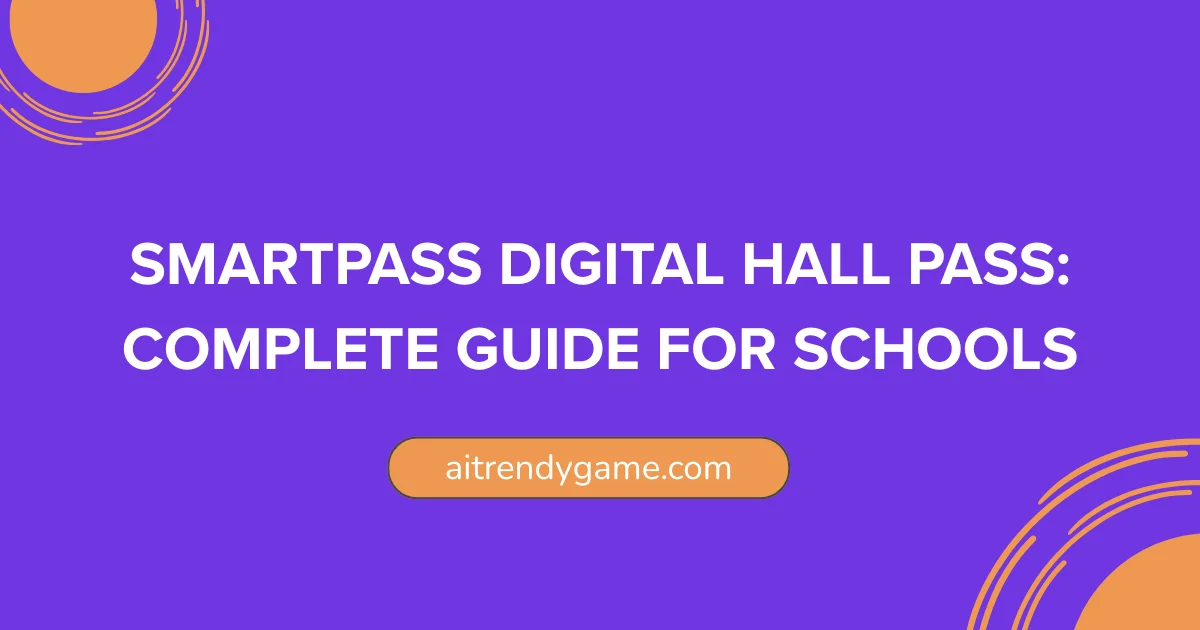
SmartPass is a digital hall pass system transforming how schools manage student movement, reducing hallway incidents by up to 64% while providing real-time accountability data. However, successful implementation requires careful planning around student concerns, technical infrastructure, and clear policies.
The traditional paper hall pass system—with its lanyards, clipboards, and sign-out sheets—has been a staple of American schools for decades. But as schools grapple with safety concerns, instructional time loss, and accountability challenges, many are turning to digital solutions. Enter SmartPass, a cloud-based platform that’s reshaping how over 3,800 schools across all 50 states manage student movement.
But is this digital revolution the answer schools have been waiting for, or does it create new problems? After analyzing real implementation data, student feedback, and administrator experiences, here’s what you need to know.
What Is SmartPass and How Does It Actually Work?
SmartPass is a digital hall pass management system that replaces physical passes with a software solution accessible through Chromebooks, iPads, or smartphones. Students request passes digitally, teachers approve them (or set up auto-approval for certain destinations), and administrators gain real-time visibility into who’s out of class and why.
The Core Workflow
When a student needs to leave class, they:
- Open the SmartPass app on their device or a classroom kiosk
- Select their destination (bathroom, nurse, counselor, locker, water fountain, etc.)
- Check if the destination has reached capacity—if so, they join a virtual queue
- Receive approval from their teacher (if required for that destination)
- Start their timed pass, which counts down the minutes they’re out of class
Teachers see active passes in real-time through a “Hall Monitor” dashboard that displays student names, profile pictures, destinations, and remaining time. The system automatically flags students who exceed their allotted time or attempt to meet up with blocked contacts.
Beyond Basic Passes: SmartPass Capabilities in 2025
SmartPass has evolved significantly since its student-founded startup days. After being acquired by Raptor Technologies in December 2024, the platform now offers:
Encounter Prevention: AI-powered detection identifies students who frequently end up in hallways together. Administrators can create “encounter prevention groups” that automatically block these students from having overlapping passes—a powerful tool for preventing vaping, vandalism, or confrontations.
Emergency Management: During lockdowns or emergencies, administrators can instantly alert all staff, require teachers to account for students in their rooms (including those pulled in from hallways), and prevent new pass creation. The system provides a real-time birds-eye view of every student’s location.
Flex Scheduling: Beyond hall passes, SmartPass Flex helps schools manage activity periods, study halls, and flexible scheduling with digital sign-ups and attendance tracking.
Digital ID Cards: Integrated student ID functionality eliminates the need for separate physical cards while enabling quick identification in hallways.
Parent Portal: Parents can access their child’s pass history, attendance records, and even grades through a unified portal—increasing transparency and enabling productive home-school conversations.
The Case for Digital Hall Passes: What the Data Shows
The numbers tell a compelling story about SmartPass’s impact on school operations and culture.
Dramatic Reductions in Hallway Incidents
Lincoln East High School in Nebraska provides one of the most striking examples. Principal Casey Fries reported a 64% decrease in suspensions and a 23% decrease in course failures in their first year using a digital hall pass system. The school culture, previously strained by hallway management issues, transformed to one “filled with joy, hope, and gratitude.”
At Shawnee Middle School in Oklahoma, Principal Keely Tolin observed that “the issues that we’re having in the middle of class, in the hallways or in the bathrooms, have gone down dramatically” after implementing SmartPass. The encounter prevention feature specifically cut down on vandalism and fighting.
Camelback High School reported a 30-40% reduction in students in hallways at any given time—meaning more students remained in class learning.
Instructional Time Recovery
When schools surveyed by the National Center for Education Statistics, 48% reported that “rowdiness outside of the classroom” had increased. This isn’t just a disciplinary issue—it’s a learning time issue.
Before SmartPass, teachers spent valuable minutes writing passes, managing sign-out sheets, and tracking down students who disappeared into hallways. Berlin High School’s administration noted their “paper system was broken. Teachers were losing valuable time writing passes, and we had no real data on where students were or how long they were out.”
With digital passes, teachers can approve requests with a single tap, and students who know their time is being tracked tend to return more quickly. Jessica Roman, a teacher at Lutheran High School Association in Michigan, observed: “Kids have been more timely in their bathroom trips and ask less often.”
Data-Driven Conversations Replace Guesswork
Perhaps the most significant shift isn’t about preventing misbehavior—it’s about having concrete information to support struggling students.
Rich DiMauro, K-12 Instructional Technology Coach at Pinelands Regional School District, explained: “SmartPass is more than a digital hall pass tool. It’s a student accountability system that has transformed our school and helps keep students where they are supposed to be—in class.”
The data allows counselors and administrators to identify patterns early. A student consistently missing class time might be struggling with anxiety, health issues, or social challenges. Previously, these patterns went unnoticed until grades dropped. Now, schools can intervene proactively using missed class time data as part of their Response to Intervention (RTI) or Multi-Tiered System of Supports (MTSS) frameworks.
The Student Experience: Perspectives from the Classroom
While administrators celebrate reduced hallway chaos, many students have voiced legitimate concerns about SmartPass implementation. Understanding these perspectives is crucial for successful adoption.
Real Concerns from Students
A student at Liberty High School, writing after one week of SmartPass implementation, articulated several pain points that resonate across schools:
Technical Friction:
Getting out and logging in to my Chromebook in the middle of class not only disrupts my learning but also the students around me. These issues are exacerbated by slow internet speeds and poorly functioning Chromebooks. The process of creating an e-pass takes significantly more time than simply asking to leave the room with a traditional paper or lanyard pass.
This is a valid concern. In schools with unreliable WiFi or outdated devices, digital passes can create more disruption than they prevent. Implementation success depends heavily on technical infrastructure.
Universal Restrictions for Individual Problems:
“I believe that it is unfair that the whole of the student body has to abide by this system that is targeting a small demographic of students. To me, a better solution would be to have only select students using the e-pass system, students with a history of attendance issues.”
This sentiment reflects a broader tension: digital surveillance systems designed to prevent misbehavior by some can feel punitive to students who’ve never caused problems.
Health and Mental Health Accommodations:
“The system does not take into account students who may have health issues that require more bathroom passes or students who menstruate who may need more bathroom passes during their cycle. It also restricts students from taking short mental health breaks during classes.”
Fortunately, SmartPass allows administrators to customize pass limits for individual students. Schools can provide accommodations for students with IEPs, 504 plans, or medical conditions. However, the default implementation needs thoughtful policy around exceptions to avoid stigmatizing students who need them.
Cost Concerns: “From my research, I found that SmartPass costs between two and five dollars per student, which adds up to several thousand dollars. In a time when public school funding is sparse, I think this money could be used more productively.”
The cost consideration is real. For a school of 1,000 students, this represents $2,000-$5,000 annually. However, SmartPass is eligible for ESSER, Title, IDEA, and other federal and state grant funding, which has helped many schools afford implementation.
When SmartPass Works Well for Students
At Tulsa Union’s 6th and 7th Grade Center, 6th Grade Principal Tammy Ward noted that SmartPass actually reduced frustration by creating uniform procedures: “We were actually doing a lot of whole classroom breaks. The teacher would take down the whole class, then they’d have to be waiting for each of them to go in and use the restroom. So [SmartPass] has really eliminated that process now that they can just submit their request and go.”
Students at schools with consistent implementation often appreciate knowing exactly how the system works, rather than navigating different teachers’ varying hall pass policies.
Privacy and Data Security: What Parents Need to Know
“Is this tracking my child’s every movement?” is often the first question parents ask about digital hall pass systems.
What SmartPass Actually Tracks
SmartPass is not a GPS tracking system. It doesn’t follow students around the building or create a live location map. Instead, it logs:
- Pass request time and approval time
- Intended destination selected by the student
- Duration of the pass and return time
- Teacher who approved the pass
- Total missed class time accumulated over days/weeks/terms
This is fundamentally a record-keeping system—like a digital version of the sign-out clipboard, but with timers and analytics.
Data Handling and Compliance
SmartPass and its parent company Raptor Technologies maintain that student information is kept only for client schools’ reporting purposes and never sold to third parties. The platform is designed to comply with FERPA (Family Educational Rights and Privacy Act) and COPPA (Children’s Online Privacy Protection Act) regulations.
Ivan Casanova, Chief Marketing Officer at Securly (a competing digital hall pass provider), emphasized a similar stance: “It’s your data. We help you manage that data—if you want to delete that data, we provide mechanisms for doing things like that. But at the end of the day, it’s your data and you control it.”
Schools implementing SmartPass should publish clear privacy policies to parents explaining what data is collected, how it’s used, how long it’s retained, and who has access.
At Tulsa Union, Principal Ward reported: “I haven’t received any concerns from parents about data privacy.” Transparency from the outset helps build trust.
Implementation Best Practices: Lessons from 3,800+ Schools
The difference between a smooth SmartPass rollout and a chaotic one often comes down to preparation and communication.
Start with a Pilot Program
Rather than deploying SmartPass district-wide immediately, successful implementations begin with 1-2 schools or specific grade levels. This allows administrators to:
- Identify technical issues before they affect thousands of students
- Refine policies based on real-world feedback
- Build a case study showing measurable improvements to convince skeptical staff
Districts typically see reductions in tardies and hallway incidents within 30-60 days of pilot implementation—data that helps justify broader adoption.
Define Clear Policies Before Launch
Schools need to establish and communicate:
Pass Limits: How many passes can students request per day, week, or term? Common settings are 3-5 bathroom passes per day or 10-15 per week.
Cooldown Periods: How much time must pass between bathroom breaks to prevent gaming the system?
Destination Capacity: How many students can be in a bathroom, nurse’s office, or hallway at once?
No-Fly Times: Are there certain periods (like the first/last 10 minutes of class) when non-emergency passes aren’t allowed?
Individual Accommodations: What’s the process for students with medical needs, IEPs, or 504 plans to receive modified limits?
Emergency Overrides: How can teachers bypass the system for urgent situations?
Train Both Staff and Students Thoroughly
The technology is only as good as the people using it. Effective training includes:
For Teachers:
- How to approve/deny passes
- How to use Hall Monitor dashboard
- When and how to override system restrictions
- How to interpret pass data for student support conversations
- Reporting features for identifying frequent flyers
For Students:
- Step-by-step pass creation process
- Understanding queue systems and capacity limits
- Consequences for exceeding time limits
- How to request accommodations if needed
- Privacy protections in place
Virtual and live training sessions should be available, and schools should designate “SmartPass champions” among staff who can provide peer support during the transition.
Address Technical Infrastructure First
SmartPass requires:
- Reliable WiFi coverage throughout the school building
- Sufficient device availability (1:1 Chromebooks, iPads, or classroom kiosks)
- Integration with Student Information Systems (via Google, ClassLink, Clever, or CSV import)
- Profile pictures uploaded for quick identification in Hall Monitor
Schools with spotty WiFi or outdated devices should upgrade infrastructure before implementing digital passes. Otherwise, the system creates more problems than it solves.
Build Buy-In Through Transparency
Derek Stampone, Assistant Principal at The High School of Fashion Industries, emphasized showing staff the value: “It was really important to me that my teacher’s momentum wouldn’t be interrupted. The implementation was pretty easy because our teachers didn’t have to do anything extra in the process to make it work.”
Similarly, students need to understand the “why” behind SmartPass. Frame it not as distrust, but as a tool that:
- Helps schools keep everyone safer during emergencies
- Provides data to support students who need help
- Creates fair, consistent policies across all classrooms
- Reduces interruptions so everyone can focus on learning
Monitor and Adjust Based on Data
After launch, track metrics including:
- Average pass duration by destination
- Frequent flyers (students with excessive passes)
- Peak hallway traffic times
- Tardiness rates before and after implementation
- Hallway incident reports before and after implementation
- Teacher satisfaction scores
- Student feedback through surveys
Use this data to refine policies. If bathroom passes average 3 minutes but the limit is 5, consider adjusting. If certain times show hallway congestion, implement strategic no-fly periods.
Alternatives to SmartPass: The Digital Hall Pass Landscape
SmartPass isn’t the only player in this space. Schools should compare options based on their specific needs:
Securly Pass
Part of Securly’s comprehensive school safety platform, Securly Pass integrates with their classroom management and web filtering tools. Schools already using Securly for other purposes may find this integration valuable.
Key differentiator: Strong focus on integration with broader student monitoring ecosystem.
Minga
Minga takes a gamified approach to hall passes, incorporating points and rewards systems. Some schools find this increases student engagement with the system.
Key differentiator: Reward-based motivation rather than purely accountability-focused.
ScholarChip
Offers both digital hall passes and broader student management features including lunch account management and campus ID systems.
Key differentiator: Multi-purpose platform beyond just hall passes.
Custom Solutions
Some districts with strong IT departments build proprietary systems tailored to their exact needs. This offers maximum customization but requires ongoing internal support.
Making the Decision: Is SmartPass Right for Your School?
SmartPass makes the most sense for schools that:
Have Identified Specific Problems: Data showing excessive hallway time, frequent bathroom vandalism, vaping issues, or students meeting up inappropriately. SmartPass is a solution—make sure you’re clear about what problem you’re solving.
Possess Adequate Technical Infrastructure: Reliable WiFi, sufficient devices, and IT staff to support integration and troubleshooting.
Can Invest in Training: Both financial resources for the platform ($2-5 per student annually) and time for comprehensive staff and student training.
Are Prepared for Cultural Shift: Moving to digital accountability requires buy-in from teachers, students, and parents. Expect resistance and plan for how to address concerns.
Commit to Using the Data: The value isn’t in the passes themselves—it’s in the insights. Schools need staff dedicated to analyzing patterns and having supportive conversations with students who struggle.
SmartPass may not be the right fit for schools that:
- Have unreliable internet or insufficient devices
- Lack IT support for troubleshooting and integration
- Have limited budget without access to grant funding
- Have a strong paper system working well with high fidelity
- Have very small student populations where personal oversight is already effective
The Future of Student Movement Management
The rapid adoption of digital hall pass systems reflects broader trends in education technology: using data to inform decisions, increasing transparency, and leveraging automation to reduce administrative burden.
SmartPass’s acquisition by Raptor Technologies signals that these tools are becoming core components of school safety infrastructure—alongside visitor management, emergency notification, and threat assessment systems.
Looking ahead, we’ll likely see:
Deeper AI Integration: Beyond encounter prevention, machine learning could predict which students might need proactive support based on pass patterns, helping counselors intervene before crises emerge.
Enhanced Wellness Features: Digital passes could incorporate mental health breaks, counselor check-ins, and resource room visits as built-in options, normalizing student wellness support.
Seamless Multi-System Integration: As schools use increasingly sophisticated student information systems, hall passes will connect with attendance, grades, behavioral interventions, and parent communication in unified dashboards.
More Sophisticated Privacy Controls: As students and families become more savvy about data rights, systems will need granular controls over what’s collected, who can access it, and how long it’s retained.
Practical Steps for Getting Started
If your school is considering SmartPass, here’s a realistic action plan:
1: Assessment (1-2 months)
- Document current hall pass challenges with specific data
- Survey teachers about pain points with existing system
- Review technical infrastructure (WiFi reliability, device availability)
- Research grant funding opportunities (ESSER, Title, state programs)
- Visit schools already using SmartPass to observe real implementation
- Form a committee representing teachers, administrators, IT, counselors, and potentially student representatives
Phase 2: Pilot Planning (2-3 months)
- Select 1-2 schools or grade levels for pilot
- Establish baseline data (hallway incidents, pass frequency, instructional time loss)
- Define pass limits, restrictions, and exception processes
- Ensure FERPA/COPPA compliance and draft parent communication
- Coordinate with IT for integration testing
- Schedule training sessions for pilot participants
3: Pilot Implementation (3-6 months)
- Launch with intensive support for first two weeks
- Gather weekly feedback from teachers and students
- Monitor data daily to identify issues quickly
- Adjust policies based on real usage patterns
- Document challenges and solutions for future expansion
Phase 4: Evaluation and Scaling (Ongoing)
- Compare pilot data to baseline metrics
- Present findings to district leadership and board
- Refine policies based on lessons learned
- Expand to additional schools/grades in waves
- Continue gathering feedback and making improvements
Key Takeaways for Schools Considering Digital Hall Passes
The problem is real: Unmanaged hallway time contributes to safety issues, instructional time loss, and accountability gaps that paper systems can’t address at scale.
The technology works—when implemented well: Schools with strong infrastructure, clear policies, and comprehensive training see measurable improvements in hallway incidents and student accountability.
Student concerns are valid and must be addressed: Technical friction, health accommodations, and perceptions of surveillance require thoughtful policy solutions, not dismissal.
Data is the real value: The power isn’t in digital passes themselves, but in using pass patterns to identify students who need support before problems escalate.
One size doesn’t fit all: SmartPass solves specific problems. Schools should honestly assess whether those are their problems and whether they have the resources for successful implementation.
Cost can be offset: Federal and state grant programs often cover digital hall pass systems as part of school safety or technology initiatives.
Cultural change takes time: Don’t expect immediate enthusiasm. Build trust through transparency, address concerns directly, and demonstrate measurable benefits.
The shift from paper to digital hall passes mirrors broader changes in how schools operate—using technology to work smarter, not just harder. SmartPass and similar systems won’t solve every challenge schools face, but when implemented thoughtfully with appropriate safeguards, they can significantly improve safety, accountability, and instructional time.
The question isn’t whether digital hall passes represent progress—it’s whether your school is ready to implement them effectively.
Frequently Asked Questions
How much does SmartPass cost?
SmartPass typically costs between $2-5 per student annually. For a school of 1,000 students, this translates to approximately $2,000-$5,000 per year. The system is eligible for ESSER, Title, IDEA, and other federal and state grant funding, which many schools use to cover costs. Contact SmartPass directly for exact pricing based on your school’s size and needs.
Can students with medical conditions get more bathroom passes?
Yes. SmartPass allows administrators to customize pass limits for individual students. Students with IEPs, 504 plans, or medical documentation can receive modified limits that accommodate their needs. Schools should establish a clear process for requesting and approving these accommodations while maintaining student privacy.
What happens if a student’s pass expires while they’re still out?
When a pass expires, the system flags it in the Hall Monitor dashboard, alerting teachers and administrators. However, students aren’t physically prevented from returning to class. The teacher can address the situation appropriately—sometimes there are legitimate reasons for going over time. The system creates accountability and data, but human judgment still guides responses.
Does SmartPass work during emergencies or lockdowns?
Yes, SmartPass includes specific emergency management features. Administrators can instantly alert all staff, instruct teachers to account for students in their rooms (including those pulled in from hallways), and automatically prevent new pass creation during emergencies. The system provides a real-time view of every student’s last known location.
Is SmartPass compliant with student privacy laws?
SmartPass is designed to comply with FERPA (Family Educational Rights and Privacy Act) and COPPA (Children’s Online Privacy Protection Act). Student data is maintained only for school reporting purposes and is not sold to third parties. Schools should review Raptor Technologies’ privacy policies and ensure their own data handling procedures align with legal requirements.
What if students don’t have personal devices?
SmartPass works on any internet-connected device—Chromebooks, iPads, computers, or smartphones. Schools can also set up kiosk mode on shared classroom devices for students to request passes. The system doesn’t require students to own personal devices, making it accessible even in schools without 1:1 device programs.
Can teachers override the system for emergencies?
Yes. Teachers retain the ability to override pass limits and restrictions when genuine emergencies arise. The system provides accountability and structure, but educators maintain discretion for urgent situations requiring immediate action.
How does SmartPass prevent students from skipping class?
SmartPass doesn’t prevent skipping entirely, but it makes it more difficult and visible. The timed passes, capacity limits, and real-time monitoring mean students can’t disappear into hallways unnoticed. The data also helps identify patterns of excessive absences that warrant counselor or administrator intervention.
Found this helpful? Share it with others who might benefit!
The Premier AI Gaming Directory for Global Visibility
AITrendyGame connects game developers with 100K+ monthly users. Submit your game for instant global exposure, premium backlinks & social promotion.
Submit Your Game 🚀Related Articles

Minecraft Axolotl Guide: Find, Tame & Breed.
Axolotls are among the most beloved creatures in Minecraft, and for good reason. These colorful aquatic mobs aren’t just cute companions they’re powerful allies in underwater combat. Whether you’re planning to raid an ocean monument or simply want to collect all five color variants, this comprehensive guide covers everything you need to know about Minecraft […]

Fourth Wing Series Guide: Books, Order, TV Show & Release Dates
The Fourth Wing series has captured millions of readers worldwide with its thrilling blend of dragons, romance, and deadly war college drama. Rebecca Yarros created a fantasy phenomenon that dominates BookTok and bestseller lists. This comprehensive guide covers everything you need to know about the Empyrean series, from reading order to the upcoming Amazon TV […]

Volley Random Game Guide: Play Unblocked & Tips 2025
Volley Random stands out as one of the most entertaining and unpredictable volleyball games available online today. Furthermore, this ragdoll physics-based sports game transforms traditional volleyball into a chaotic and hilarious experience that keeps players coming back for more. Additionally, the game’s unique approach combines simple one-button controls with completely random physics, creating matches that […]

McDonald’s Training Game: Download Guide & Free POS Simulator
The McDonald’s training game has become a popular tool for learning restaurant operations and POS system management. Furthermore, this gamified training approach helps employees master cashier skills while providing entertainment for curious users who want to experience fast-food operations firsthand. McDonald’s developed these training applications to reduce onboarding time and improve employee confidence when handling […]
Ready to Join theGaming Revolution?
The future of game discovery starts here. Connect your creation with passionate players worldwide through AITrendyGame – where talented developers meet eager gamers, and great games find their perfect audience.
Your Game Here
Reach millions of players